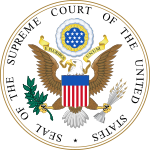Our website is made possible by displaying online advertisements to our visitors.
Please consider supporting us by disabling your ad blocker.
Ideological leanings of United States Supreme Court justices
| This article is part of a series on the |
| Supreme Court of the United States |
|---|
 |
| The Court |
| Current membership |
|
| Lists of justices |
|
| Court functionaries |
The Supreme Court of the United States is the country's highest federal court. The Court has ultimate—and largely discretionary—appellate jurisdiction over all federal courts and state court cases involving issues of U.S. federal law, plus original jurisdiction over a small range of cases.
The nine Supreme Court justices base their decisions on their interpretation of both legal doctrine and the precedential application of laws in the past. In most cases, interpreting the law is relatively clear-cut and the justices decide unanimously; however, in more complicated or controversial cases, the Court is often divided.
In modern discourse, the justices of the Court are often categorized as having conservative, moderate, or liberal philosophies of law and of judicial interpretation. It has long been commonly assumed that justices' votes are a reflection of their judicial decision-making philosophy as well as their ideological leanings, personal attitudes, values, political philosophies, or policy preferences. A growing body of academic research has confirmed this understanding, as scholars have found that the justices largely vote in consonance with their perceived values.[1][2][3] Analysts have used a variety of methods to deduce the specific perspective of each justice.
- ^ Segal, Jeffrey A.; Spaeth, Harold J. (2002). The Supreme Court and the Attitudinal Model Revisited. Cambridge: Cambridge University Press. ISBN 978-0521783514.
- ^
Epstein, Lee; Martin, Andrew D. (2012). "Is the Roberts Court Especially Activist? A Study of Invalidating (and Upholding) Federal, State, and Local Laws" (PDF). Emory Law Journal. 61: 737–758. Archived from the original (PDF) on October 9, 2012. Retrieved December 10, 2012.
…for Justices appointed since 1952, Epstein & Landes's findings parallel ours: the vast majority were opportunistic restraintists (activists), willing to uphold laws that were consistent with their policy preferences and strike those that were not.
- ^
Clark, Tom S.; Montagnes, B. Pablo; Spenkuch, Jörg L. (2022). "Politics from the Bench? Ideology and Strategic Voting in the U.S. Supreme Court" (PDF). Journal of Public Economics. 214: 104726. doi:10.1016/j.jpubeco.2022.104726. Retrieved October 30, 2022.
The evidence we present suggests that justices vote strategically, at least in part, to affect precedent.
Previous Page Next Page


